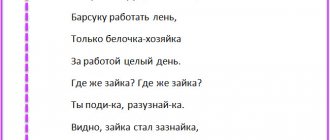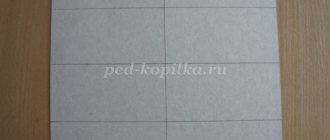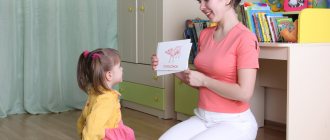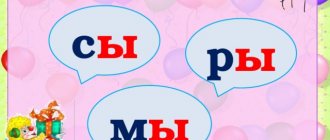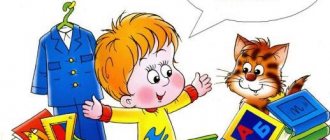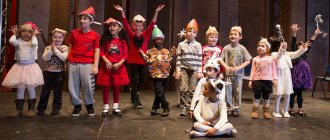Nadezhda Privalova
Didactic games for teaching sound analysis of words
Stage 1.
"How many sounds are there in a word "
Goal: development of phonemic hearing, creation of conditions for the formation in children of the skill of complete sound analysis of a word , relying on auxiliary means in the form of word .
Sound analysis of a word: what is it
First of all, it is worth giving a definition. So, sound analysis of a word is the determination of the order in which sounds are placed in a particular word and the characterization of their features.
Why do children need to learn to perform sound analysis of a word? To develop phonemic awareness, that is, the ability to clearly distinguish between sounds and not confuse words, for example: Tim - Dima. After all, if a child is not taught to clearly distinguish words by ear, he will not be able to write them down correctly. And this skill can be useful not only when studying the grammar of your native language, but also when studying the languages of other countries.
The order of parsing words by sounds
When performing a sound analysis of any word, you must first place the stress and then divide it into syllables. Then find out how many letters are in the word and how many sounds. The next step is to analyze each sound step by step. After this, it is calculated how many vowels and how many consonants are in the analyzed word. At first, it is better for children to be given simple one-syllable or two-syllable words for analysis, for example their names: Vanya, Katya, Anya and others.
When the child has gradually figured out how to correctly carry out analysis using simple examples, it is worth complicating the analyzed word examples.
Syllable and stress
Having figured out the difference between a word and a sentence, you can move on to drawing up syllable patterns. Please note that there are different conventions in textbooks. Most often, a word is represented by a line or a rectangle, which is divided by vertical lines into the required number of syllables. The accent is indicated by a short oblique stick on top. In 1st grade, work on the sound composition begins with similar word schemes.
Students of philological universities are not always able to explain the division of words into syllables in the Russian language. The easiest way is to imagine that you are communicating with a person on the other side of the river. Shout the word loudly and drawn out. Sounds pronounced in one exhalation make up a syllable. The emphasis can be determined by placing your fists one on top of the other and placing your chin on top, but not tightly. When pronouncing a stressed syllable, the pressure of the jaw on the hands will be the strongest.
Sound analysis of a word: diagram
When working with very young children, special colored cards are used to better assimilate information.
With their help, children learn to create a sound analysis scheme.
The scarlet card is used to represent vowel sounds. Blue - hard consonants, green - soft. To indicate syllables, two-color cards in the same color scheme are used. With their help, you can teach your child to characterize sounds and whole syllables. You also need a card to indicate stress and a card to show the division of the word into syllables. All these designations, which help teach a child to make a sound analysis of a word (the diagram plays an important role in this), are approved by the official school curriculum in Russia.
Classification of sounds
In turn, sounds are also sorted into two groups. Their main difference from each other is the anatomy of formation. What classes exist:
- Consonants. When pronouncing them, a person faces obstacles. The barrier is one organ or a whole group of them (lips, teeth or tongue).
- Vowels. With the help of the larynx and individual parts of the oral cavity, air leaves the lungs without any interference - this is how a vowel sound is formed.
To understand the remaining differences, it is necessary to analyze each concept in detail.
Types of vowels
In total, there are 6 vowel sounds in the Russian language (o, i, a, e, ы, u), but up to 10 letters are used to denote them in writing. This is due to the fact that some of the vowels can have several letter designations at the same time. For example, there is a semivowel “th”. It is worth considering that in the school curriculum it will be indicated by a consonant sound. Also, its purpose is to display additional vowels (I, e/e, yu). In phonetic analysis it will look like:
- I - [ya];
- e - [ye];
- yu - [yu];
- ё - [yo].
However, these vowels will not always appear as two letter elements in the diagram. The rule holds only in certain conditions:
- At the beginning of the word. (Yana, January).
- After vowel sounds (safe haven, young mother, high-speed train).
- After the hard/soft sign (enter the house).
Otherwise, these vowels will soften, but they will not give a double sound together with “y” (guys, wind).
Vowel sounds and their brief characteristics. Diphthongs
Before you start analyzing a word, it is important to know what features all phonetic sounds (vowels/consonants) have. When teaching children in the early stages, it is necessary to provide information only about the simplest properties; the child will learn everything else in high school.
Vowel sounds (there are six of them: [o], [a], [e], [s], [u], [i]) can be stressed/unstressed. Also in Russian there are letters that in a certain position can produce a pair of sounds - ё [yo], yu [yu], ya [ya], e [ye].
If they follow consonants, they sound like one sound and add softness to the preceding sound. In other positions (the beginning of a word, after vowels and “ъ” and “ь”) they sound like 2 sounds.
Card index of games for sound analysis
Game index
By studying the topic
"Sound analysis of words"
The main task in the process of teaching literacy is to form in preschoolers a general orientation in the sound system of the language, teaching them the sound analysis of words, i.e. determining the order of sounds in a word, establishing the distinctive role of sound, its main qualitative characteristics. As is known, children with normal speech throughout preschool age acquire the necessary vocabulary, master grammatical forms, and become ready to master the sound and morphemic analysis of words.
In the older group, children acquire the skills of sound analysis of words of various sound structures, differentiation of vowels, hard and soft consonant sounds. They gain knowledge about the syllabic structure of words and word stress.
In the preparatory group, children become familiar with all the letters of the Russian alphabet and the rules for writing them, and master syllabic and continuous reading methods.
So, it is important that children learn to focus on the letter of the vowel following the letter of the consonant. To do this, the main thing in the pre-letter period is to teach preschoolers to distinguish between vowels and consonants, stressed and unstressed vowels, soft and hard consonants. Adapted the system by D.B. Elkonin for preschoolers L.E. Zhurova.
Stages of sound analysis
The process of sound analysis is a special thought process. And like any mental action, it goes through several stages.
Stage 1. Intonation selection of sounds.
His tasks:
- teach children to highlight any sounds in words - intonation (dddom). The word should be pronounced together - one sound cannot be separated from the other.
- highlight and name words that contain the desired sound (first relying on clarity - a picture, an object).
- develop the ability to pronounce sounds in isolation and highlight the first sound in a word.
- determine the place of the sound - at the beginning, middle, end of the word.
That is, the first thing that children need to be taught in sound analysis is to distinguish the sound intonationally.
Important! The diagram should be used when children learn to distinguish sounds intonationally and, on the basis of this, determine their places in a word. The teacher introduces the sound analysis scheme using the example of the word ay.
Algorithm (execution sequence) - the word is pronounced drawn out - 1 sound aaa is highlighted - 2 sound uuu is highlighted. Due to their characteristics, it is difficult for preschoolers to rely only on pronunciation, establishing the order of sounds. We need a kind of mark, clarity, feature.
And Elkonin proposed modeling words in the form of a picture diagram of the sound composition. The picture shows an object whose name word must be analyzed. Below the picture is a graphical diagram of sound analysis in the form of horizontal cells according to the number of phonemes. Along with the diagram, children are given several one-color chips. For example, cardboard, plastic; round, square; grey, yellow. The circuit is filled with chips based on the sequential selection of sounds.
The picture and diagram allow you to clearly show the word in terms of subject matter. The scheme tells the child the number of sounds in a word and at the same time helps to control the actions of isolating sounds. And chips or other graphic symbols are substitutes - symbols of sounds. In the future, you can perform sound analysis without a given scheme.
2. stage. Differentiation of vowels and consonants.
Algorithm - highlighting a vowel sound + marking on the diagram with a chip - highlighting a consonant sound + marking on the diagram with a chip. At the same stage, the place of stress in the word is established, i.e. stressed vowel. There is only one stress in the word.
Correct stress is important, otherwise the word will not be recognized and understood. Algorithm - highlighting a stressed syllable - highlighting a stressed vowel sound + marking the stress location on the diagram.
3. stage. Differentiation of consonant sounds by hardness and softness (later on deafness and calls).
The algorithm is the selection of a consonant sound + determination of softness-hardness + marking on the diagram with a certain chip. Children identify soft and hard sounds. This can be explained in different ways. For example, L.E. Zhurova does this in a playful way. Paired sounds (mm/) are called “Brothers”, hard sounds are called “Angry”, soft sounds are called “Kind”.
Children are also introduced to hard and soft sounds through a play situation. For example, they bring in 2 dolls. A doll in a blue suit, frowning, angry. A doll in a green suit, cheerful. Children have pictures. They distribute them like this: they present the doll in a blue suit with a picture with the first hard sound in the word (as an option). Next, children replace the dolls with blue and green chips.
4. stage. Carrying out sound analysis without relying on clarity - a graphical diagram, and then gradually abandoning the chips. As a result, a complete sound analysis is in the mind (internally).
Techniques for teaching sound analysis of words
·Intonationally highlight the 1,2… sound.
·Intonationally highlight a given sound.
·Quantitative and ordinal counting of sounds.
·What is the first vowel (consonant) sound, what is the second... how many vowels and consonants are there in total? Consecutive pronunciation of sounds individually and in chorus.
·Schematic representation. A card with an image of an object and a sound analysis diagram, a set of chips of different colors. This material allows children to move from mechanical reading to conscious reading. It is better to first use those words that are read the same way as they are written (mother, cup). Then you can use “difficult” words (milk, spoon).
· Selection of words with a given sound (based on toys, surrounding objects, paintings, diagrams, according to verbal tasks).
·A relay race with a conditional object that is passed on, for example, a flower. The teacher says the word, then places a flower in front of the child - he names 1 sound of the word. Places a flower in front of another child - he names the 2nd sound, etc.
· Adhere to a clear algorithm when analyzing. For example, “The word... consists of 2 sounds. First second - …". “I came up with a word of 2-5 sounds...”
·Rough letters, frame inserts with letters. They are good because you can touch them and feel all the curves. It has been proven that this stimulates the child to write them. Make it with your children.
·"Trap". A teacher’s mistake when pronouncing, when working with diagrams, when correcting children’s mistakes, etc....
·Exercises such as “Name the sounds of my word”, “Add a sound to my word”, “Objects around us” (name objects from the given Z, who is bigger, faster), “Who will decorate the Christmas tree faster” (with toys with the given Z), “ Loading onto a barge” (all words starting with a given sound or with a specific sound...).
·Games such as “Toy-word”, “Picture-word” (M. Montessori). The boxes contain small toys and cards with their names. Then the toys are replaced with pictures. The challenge might be to find a specific sound.
·Game "Choir". Other children initially do not know what we are talking about. Children pretending to be Z say them together. Preschoolers try to guess and understand the word. They come to the conclusion that the Z in the word in must be pronounced one after another.
·Game-exercise “I conceived a sound.” You can guess it by asking only, for example, 7 questions. The leader is first the teacher, then the child at a later stage.
Games and exercises for teaching senior preschool children the sound analysis of words.
In preschool age, the most effective means of educating the sound side of speech is play. A didactic game is a multifaceted, complex pedagogical phenomenon: it is a game method of teaching preschool children, a form of education, an independent play activity, and a means of comprehensive education of a child’s personality and allows one to overcome various difficulties in speech.
Verbal didactic games develop auditory attention, the ability to listen to the sounds of speech, and repeat sound combinations and words.
The purpose of the games below is to teach children to listen to the sound of words; exercise them in independently naming words and clearly pronouncing the sounds in them; learn to independently find words that sound similar and different; teach children to independently recognize words that lack one sound, the last or the first; teach children to independently find long and short words; teach children to hear individual sounds within a word, exercise children in independently selecting and naming words with certain sounds.
“What sounds around us?”
Visual material: objects in the group room.
The teacher gathers the children around him and reads A.L.’s poem. Barto “Word Game”, drawing attention to the fact that words sound different because of the different sounds they contain (for example: zzoonnt, shshaarrffiik, zhuuk, rraaa). The teacher suggests repeating these words together and giving everyone their own word, but in such a way that you can clearly hear how it sounds.
"Think and Say"
Visual material: toys (bird, bear, bunny).
The teacher draws the children's attention to the fact that some words sound similar (for example: cricket, spider, bug). Then the teacher suggests choosing similar-sounding words for the toys: bird, bear and bunny (for example: little bird-tit).
The teacher encourages children who select words that are suitable in meaning and similar in sound.
“Tell Petrushka the sound”
Visual material: Parsley, screen.
Parsley tells the children that he will speak words, but in some words he will deliberately omit one last sound. The children should suggest it. The teacher carefully ensures that the children do not pronounce the entire word, but add only the sound. For example:
Parsley: A black-eared kitten was basking in the sun...
Children: k.
“What sound was lost?”
The teacher slowly reads the poetic text. In some words he deliberately does not pronounce the first sound. Children listen carefully and note which words are pronounced incorrectly, highlight them from the text, pronounce them correctly, indicating which sound was lost.
"Silence"
Visual material: toys and objects in the group room.
The teacher invites the children to look around and “search” for short and long words. A leader is selected, he must walk around the room and look for objects with a short name. Having found such an object or toy, he must stop in front of it and clap his hands. All children watch the actions of the leader and check whether he performs the task correctly. The next leader is looking for items with a long name.
"The word can be walked"
The teacher tells the children that they can find out whether a word is long or short, step by step. He says the word soup and walks at the same time. The teacher draws the children’s attention to the fact that there is only one step, then says the word ball, steps, the children step too - and again one step. “What a short word, you only have time to take one step!” says the teacher and invites the children to name different words and walk at the same time. “Whoever names the longest word is the winner. Let's start! Children name words, the teacher helps them. There is no need to count steps, the main thing is to pay attention to the duration of the sound of the word.
"The Mystery of Parsley"
The teacher, having gathered the children, informs them that he received a letter from Petrushka, and this letter contains an interesting riddle. The teacher reads the letter: “Hello, guys! I now live in the country, walk in the forest. I love picking mushrooms in the forest. I bring a lot of mushrooms home. Guess what kind of mushrooms I collect, if their names must have the sound “r” (boletus, milk mushrooms, saffron milk caps, russula...), the sound “t” (boletus, honey mushrooms...), the sound “s” (russula, sow mushrooms, boletus) , the sound “and” (boletus, boletus, saffron milk caps, russula, boletus...).” Analyzing the children’s answers, the teacher notes how the word is pronounced: does the word really have the given sound, does the child highlight it loudly and clearly enough in his voice.
“Name the first sound in the word”
Goal: developing the skill of identifying the first sound in a word.
Progress of the game: the adult names the word, the child must highlight the first sound in the word with his voice and name it exactly as the sound sounds in the word. For example: cat - in the word "cat" the first sound is K, whale - in the word "whale" the first sound is K, garden - in the word "garden" the first sound is S, hay - in the word "hay" the first sound is S, etc. As a complication, you can ask the child to characterize this sound (vowel-consonant, soft-hard), and also name the last sound in the word.
"Pick up a word"
Goal: learn to select a word with a given sound.
Progress of the game: the adult asks to choose a word with a given sound, the child names one or more words. For example: “Tell me a word with the sound Ш” - school, pencil, tinsel. “Tell me a word with the sound B” - bandage, child, squirrel. As a complication, you can ask to name words with a given sound in a certain position (at the beginning, middle and end of the word). For example: “Tell me the word Z with the sound S at the beginning of the word” - plane, catfish, trail, bag, etc.
"Catch the Sound"
Goal: developing the skill of isolating a given sound in a sound series.
Progress of the game: the adult offers to perform a certain action when the child hears a given sound among other sounds pronounced by the adult. For example: “Clap your hands when you hear the sound A,” then the adult slowly and clearly pronounces: O, A, K, U. A, B, L, O, A, etc.
Game "Replace the sound"
Goal: developing the skill of synthesizing syllables according to a given principle.
Progress of the game: the adult suggests replacing a certain sound with a given one and pronouncing the resulting syllable. For example: “Replace A with O,” then the adult slowly and clearly pronounces the syllable KA, the child “in his mind” changes A to O and pronounces KO, ZA - ZO, LA - LO, etc.
In order to teach children to identify sounds from words by ear, we play games: “Perches and Ducks”, “Friendly Sounds”, “Dolls Got Lost”, “Guess what sound is playing hide and seek with you”, “Shop”, “Sound Lotto” , “Forbidden sounds”, “a cow was flying”, “Verbal chain”, etc.
"Perches and Ducks"
Purpose of the game: to teach you to recognize by ear and distinguish the stressed vowels O and U in words.
Progress of the game. Children are divided into two teams: “perches” and “ducks”. They move randomly around the site. The presenter pronounces words alternately with the stressed sound U, then with the stressed sound O. The “perch” children must freeze when they hear a word with the sound O, and the “ducks” when they hear a word with the sound U. Those who do not stop on time are eliminated from the game . The winner is the one who never made a mistake and stayed on the court the longest.
Words for the game: hoop, vegetables, autumn, donkey, island, vacation, vacation, Olya, lake, sheep, order, cloud, corner, fishing rod, dinner, beehive, morning, smart, narrow, coal.
"The cow was flying"
Goal: development of attention, phonetic hearing; strengthening children's ability to navigate the sound structure of a word
Description of the game. There must be at least three players. Everyone sits in a circle and, turning their right hand palm down and their left hand palm up, connect their palms with the palms of their neighbors. They take turns pronouncing a word of the verse, clapping the palm of the right neighbor in time with the word: The cow was flying and said the word.
What word did the cow say?
Whoever gets the turn to answer names any word, for example, “grass.” His neighbor, along with a clap, says the first letter of this word - “t”, the next one - the second, and so on until the end of the word, until the last “a”. The task of the last player is not to gape and have time to remove his hand from under the final clap.
To teach children consistent sound analysis using chips, we organize games: “Each sound has its own room”, “How many rooms in the apartment”, “Short and long words”, “Find words according to a given model”, etc.
“Every sound has its own room”
Goal: to teach how to conduct a complete sound analysis of a word based on the sound diagram and chips.
Description of the game. Players receive houses with the same number of windows. The residents of the “word” must move into the houses, and each sound wants to live in a separate room. Children count the number of windows in the house and conclude how many sounds there should be in a word. Then the presenter pronounces the word, and the players name each sound separately and place chips on the windows of the house to “populate the sounds.” At the beginning of training, the leader says only words suitable for settling in, that is, those that will contain as many sounds as there are windows in the house. At subsequent stages, you can say a word that cannot be “settled” in a given house, and the children, through analysis, are convinced of the mistake. Such a tenant is sent to live on another street, where words with a different number of sounds live.
“How many rooms are there in the apartment?”
Goal: to teach how to determine the number of sounds in words without relying on a ready-made diagram using chips.
Description of the game. For the game, word houses are used, but without windows. Each player has one such house, as well as several chips and a set of numbers: 3, 4, 5, 6. The presenter has object pictures. He shows a picture, the children place chips in the window house according to the number of sounds, and then put the corresponding number. Then the chips are removed from the house, the presenter shows the next picture, and the children analyze the word again. At the end of the game, relying on the numbers, you need to try to remember which pictures were offered for analysis. You can ask them to choose their own words with the same number of sounds.
In order to strengthen children’s ability to navigate the sound structure of a word, develop attention and memory, the games “Guess”, “Corders”, and “Riddle Game” are used.
"Riddle Game"
Goal: to strengthen children’s ability to navigate the sound structure of a word, develop attention, memory, imagination, and thinking.
Description of the game. The teacher lays out a model of the word on the board and says: “Now we’ll play a new game. I thought of a word. It consists of the following sounds: the first sound is a soft consonant, the second is a vowel, the third is a hard consonant, and the last is again a vowel. (At the same time, the teacher guides the model with a pointer, drawing the children’s attention to it.) Guess what word this is? To guess, you must know what I asked the riddle about. You ask me whether it is alive or not, and it will immediately become easier for you to guess: if it is alive, then it is either a person, or an animal, or a plant, but then you no longer need to name any objects. And if it’s inanimate, then, on the contrary, you need to find out what it refers to. Ask!”
To teach children syllabic analysis, we offer the following games: “Make a word from syllables”, “Hot ball”, “Make a word”, “Picture - basket”, “Half the word is yours”, etc.
“Make a word from syllables”
Goal: teaching meaningful reading
Description of the game. Cut a two-syllable word into syllables, for example: RE, KA. Invite your child to assemble a word from syllables; he determines the sequence himself. A child can get both CARE and RIVER. To choose the correct sequence of syllables, the child comprehends their combination.
"Hot Ball"
Goal: to teach how to highlight the first and last syllables in words, to develop attention.
Description of the game. Players are divided into two teams and line up facing each other. The end player in one of the rows receives the ball. He says the beginning of a word, for example “we-”, and throws the ball to the player standing opposite, while he runs to the end of the row. He catches the ball, pronounces the ending of the word, for example “-shi”, passes the ball to his neighbor in the line and also runs to the end. The next player says the beginning of the word again, etc. If the player cannot form a word, then he passes the ball to his neighbor and leaves the game. The team with the most players left at the end of the game wins.
As a result of such consistent, step-by-step familiarization with the sound side of a word, the child learns to hear and identify all the sounds in any word, to be well oriented in the sound structure of the word, and also to firmly remember the instructions, formulations and tasks of an adult related to the sounding word, and to carry them out meaningfully. These games and exercises contribute to the speech development and development of thinking of preschoolers, provide children with positive emotions throughout the entire process of preparing for literacy.
Thus, from the above it follows that one of the tasks of preparing a child for schooling includes the formation of a certain level of speech development, in particular, correct pronunciation and speech perception. As a result, readiness for sound analysis and synthesis of speech is formed, which is the cornerstone in learning to read and write.
Brief characteristics of consonants
There are thirty-six consonant sounds in our language, but they are represented graphically by only twenty-one characters. Consonants are hard and soft, as well as voiced and voiceless. They also may/may not form pairs.
The table below lists voiced and unvoiced sounds that can form pairs, and those that do not have this ability.
It is worth remembering: the consonant sounds [th`], [ch`], [sh`] are soft in any position, and the consonants [zh], [ts], [sh] are always hard. The sounds [ts], [x], [ch`], [sch`] are absolutely always unvoiced, [m], [n], [l], [р], [й`] are (sonorous) or voiced .
Soft and hard signs do not produce sounds. The soft sign makes the previous consonant soft, and the hard sign plays the role of a sound separator (for example, in Ukrainian the apostrophe plays a similar role).
Learning to think
Most often, schoolchildren's mistakes are associated with a formal approach. The lexical meaning of the word is not taken into account. Children try to find already familiar suffixes in the word (-chik- in the lexemes “ball”, “ray”), prefixes (-u- in the adjectives “morning”, “narrow”). To avoid this, children are taught to select words to match the indicated patterns. You can create such tasks yourself.
Draw a diagram of the word: root + suffix + ending. Which of the lexemes listed above are suitable for it: racer, raincoat, storekeeper, cartiler? Which words have a zero ending, a prefix and a root: raid, tune, burbot?
Drawing up a word diagram is quite a difficult task for a primary school student. In order not to discourage your interest in studying with boring workouts, turn them into a game. Conduct lessons for dolls, organize competitions with prizes, and for correct answers, give a part of the picture that will need to be assembled in the end. Put in a little effort and it will definitely be rewarded.
